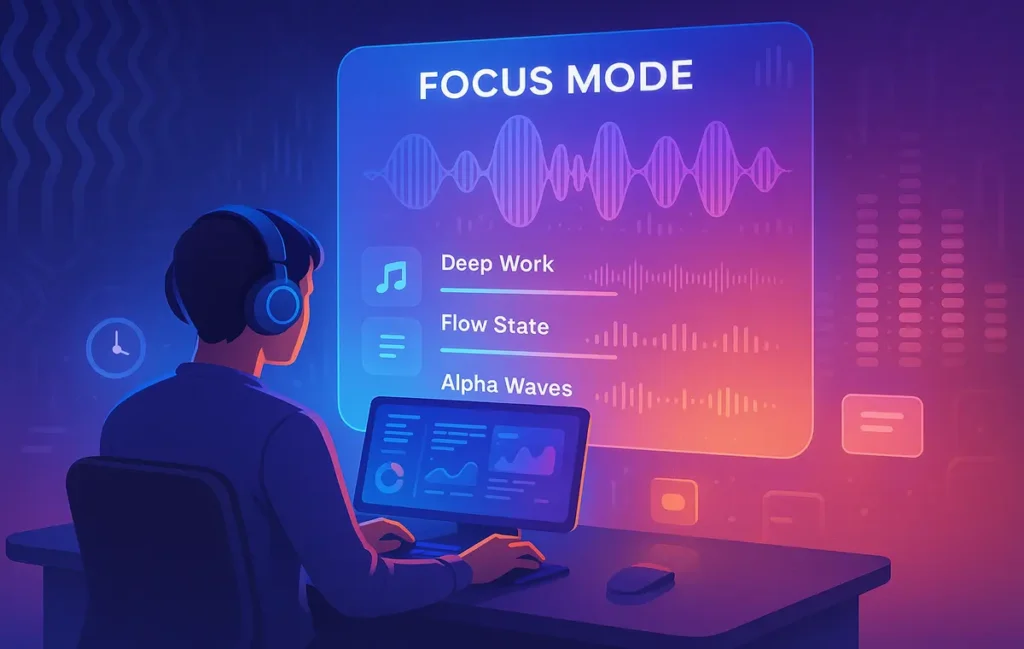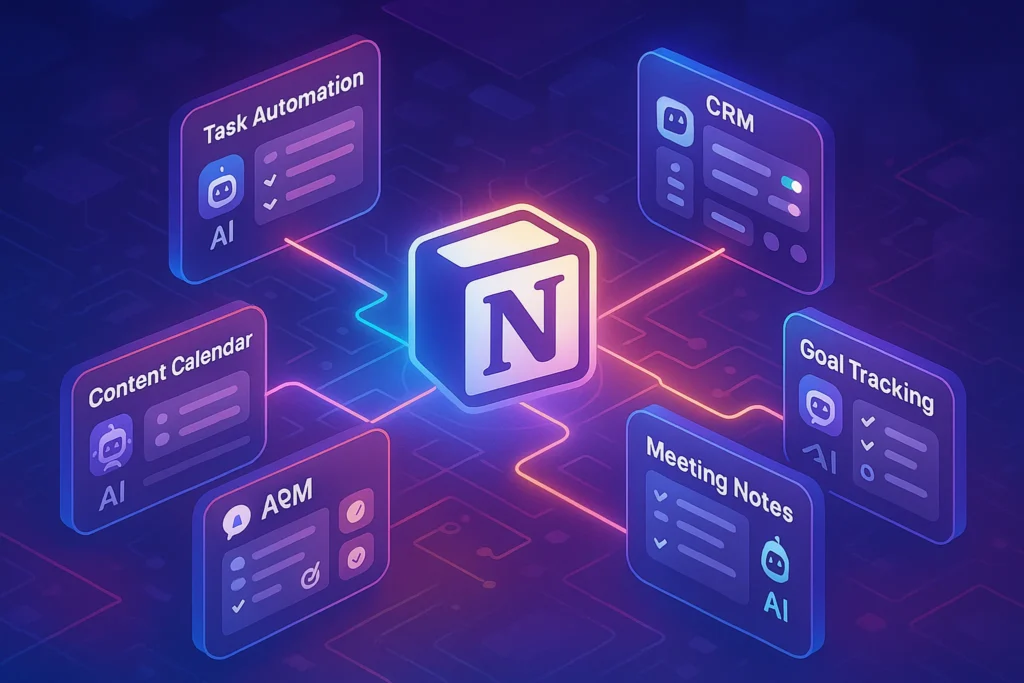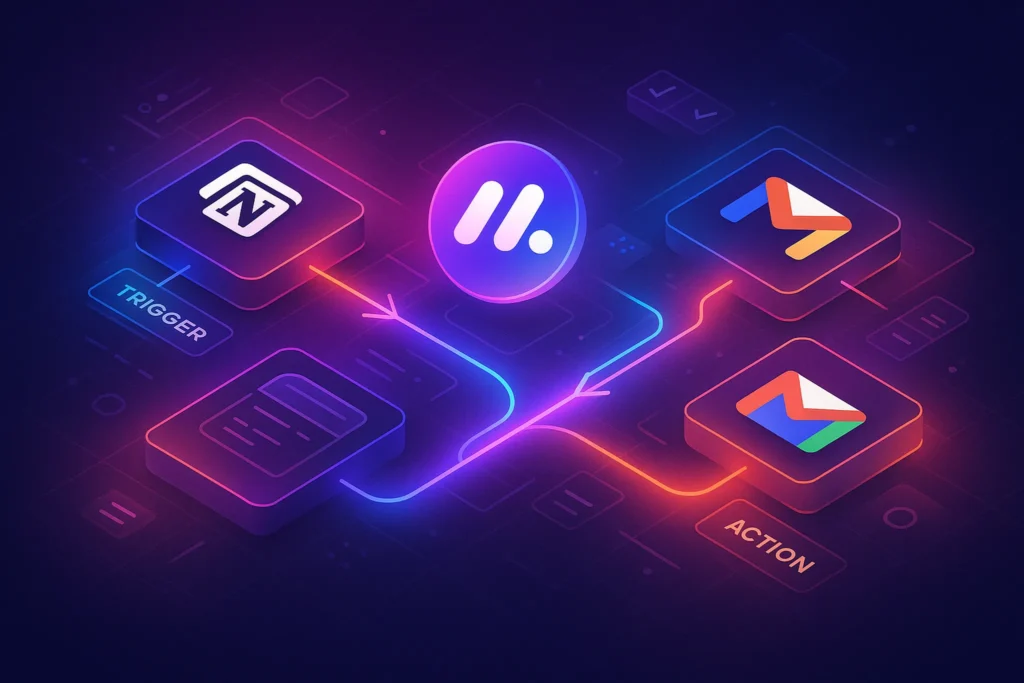🌍 The Global Problem of Distraction (and How Music Helps)
Distraction is now a universal challenge. From constant notifications to noisy work environments, staying focused for even thirty minutes can feel like a battle. The average knowledge worker gets interrupted every 11 minutes, and it takes more than 20 minutes to fully regain focus afterward. No wonder productivity is under pressure across industries.
This is where music enters the picture—not as entertainment, but as a tool. Research shows that carefully structured soundscapes can nudge the brain into focus, improve retention, and even trigger flow states. Unlike random playlists or background chatter, purpose-built focus music apps apply neuroscience and psychology to help you work better.
💡 Nerd Tip: Treat music like a productivity tool, not just background noise. When designed with intention, it can become your competitive edge.
For readers who want to double their concentration with schedule design, we’ve also written the Beginner’s Guide to Time Blocking for Focus and Flow. Combining time blocks with focus music compounds results dramatically.
🧠 The Science of Focus Music
The effectiveness of focus music isn’t hype—it’s backed by decades of research. One of the core mechanisms is brainwave entrainment, where rhythmic auditory patterns encourage the brain to sync with frequencies linked to concentration (typically beta waves for alertness or alpha waves for relaxed focus).
White noise also plays a role by masking environmental distractions. In open offices or noisy homes, consistent background sounds reduce interruptions to working memory. Instrumental tracks, particularly those without lyrics, prevent language-processing centers in the brain from being overloaded, leaving more capacity for task-related thinking.
Studies suggest that structured sound environments can increase productivity by 15–20%, particularly in repetitive or cognitively demanding tasks. The science is clear: music designed for focus works differently than your personal Spotify shuffle.
💡 Nerd Tip: If your playlist has vocals, your brain is multitasking between lyrics and tasks. Stick with instrumental or science-backed soundscapes.
For more context on attention, check our piece on How to Stay Focused, which explores psychological techniques you can combine with focus music.
🎼 Why Playlists Matter
Not all music is created equal when it comes to productivity. Listening to your favorite songs may feel motivating, but personal tracks often trigger emotional or memory associations that distract from the task. Science-backed playlists, on the other hand, are curated specifically to optimize focus.
These playlists are designed with tempo, key, and progression in mind. They gradually build cognitive engagement without startling shifts that can break concentration. Apps like Brain.fm, for instance, use AI-generated compositions that continuously adapt to your brain’s state, while Spotify’s curated “Focus” collections stick to tried-and-tested instrumental formulas.
💡 Nerd Tip: The difference between random playlists and focus playlists is like the difference between casual jogging and a structured training program. Both involve running, but only one is built for performance.
📱 Top Focus Music Apps in 2025
Brain.fm
Brain.fm is often called the gold standard in focus music. Its AI-generated tracks are based on neuroscience principles, adapting to your focus levels in real time.
-
Pros: Scientifically validated, adaptive playlists, effective for deep work.
-
Cons: Subscription required, less useful for casual listening.
Endel
Endel offers soundscapes tailored to time of day, mood, and activity. Its AI engine generates endless loops for focus, relaxation, or sleep.
-
Pros: Highly adaptive, mobile-first, beautiful UI.
-
Cons: Can feel less structured compared to Brain.fm.
Noisli
Noisli lets you create custom blends of white noise, rain, wind, and ambient sounds. Perfect for blocking distractions.
-
Pros: Simple, customizable, free tier available.
-
Cons: Less musical, more for noise masking than flow states.
Focus@Will
This app blends neuroscience and curated instrumental music, offering playlists tailored by personality type.
-
Pros: Wide variety, personality quiz, strong for creative tasks.
-
Cons: Interface feels dated compared to newer apps.
Spotify Focus Playlists
Spotify isn’t built for science-backed focus, but its “Deep Focus” and “Instrumental Study” playlists are widely used.
-
Pros: Free (with ads), accessible, familiar.
-
Cons: Not neuroscience-driven, occasional track breaks in flow.
💡 Nerd Tip: Try multiple apps and track your productivity. What matters isn’t the hype but which soundscapes truly help you sustain deep work.
For readers interested in blending focus tools with mindfulness, see Mindfulness Tech where we explore how meditation apps and focus tools can complement each other.
🧩 Use Cases for Different Work Modes
Focus music isn’t one-size-fits-all. Different work modes benefit from different types of soundscapes:
-
Deep Work / Flow: AI-generated focus tracks (Brain.fm, Endel) that sustain concentration for hours.
-
Creative Tasks: Ambient or experimental music that sparks new associations without distracting lyrics.
-
Repetitive Admin Work: White noise or consistent beats from Noisli to reduce boredom and fatigue.
-
Relaxed Focus (Mindful Tasks): Slow instrumental or nature sounds that calm while keeping attention steady.
💡 Nerd Tip: Pair each work mode with a matching playlist. Over time, your brain will associate specific soundscapes with task types, making focus easier to trigger.
For science-driven strategies beyond music, read Top Productivity Hacks Backed by Science for evidence-based techniques you can stack with focus playlists.
🏢 Case Study: Focus Music in Action
A remote-first design agency noticed declining productivity during long project sprints. Team members reported difficulty concentrating while working from home. The agency adopted Brain.fm for deep work sessions and Noisli for collaborative environments. Within six weeks, employee surveys reported a 30% reduction in distractions and a 22% increase in project completion speed.
One designer wrote on X:
“I never realized how much random playlists were breaking my flow. Switching to science-backed focus music was like flipping a switch.” – @uxcreator
This example shows that focus music isn’t just a personal hack—it can become an organizational advantage when implemented systematically.
🔄 How to Integrate Focus Music into Your Routine
The benefits of focus music multiply when it’s part of a structured routine. Start by pairing music with time blocking—dedicated deep work slots where you commit to a single task. Put on headphones, eliminate distractions, and let your chosen soundscape become a cue for concentration.
Volume matters too. Music should sit in the background, not dominate your attention. Most focus apps recommend keeping sound at 40–50 dB, roughly the level of a quiet conversation. Track selection also matters; avoid shuffling between genres mid-session.
💡 Nerd Tip: Treat music like caffeine—dose it strategically. Overuse dulls its impact, but the right timing creates a powerful productivity edge.
For better scheduling of focus sessions, our guide to Best Smart Calendar Apps for Productivity shows how to align playlists with time management tools.
⚡ Ready to Upgrade Your Focus?
Discover apps like Brain.fm, Endel, and Noisli. Join thousands of professionals using science-backed playlists to unlock flow and boost productivity.
🧠 Neuroscience of Flow States
When people describe being “in the zone,” they’re actually experiencing a neurological phenomenon called the flow state. During flow, the prefrontal cortex—the part of the brain associated with self-monitoring and overthinking—reduces activity, allowing creativity and deep focus to flourish. Music plays a crucial role here because rhythmic and predictable sound patterns stimulate dopamine release, which helps sustain motivation.
Research has also shown that certain tempos (usually in the 60–80 BPM range) sync with resting heart rates, creating physiological calm while keeping mental energy high. Pair this with binaural beats, where two slightly different frequencies played in each ear generate a perceived third frequency, and you can nudge the brain toward states associated with deep concentration or relaxation.
💡 Nerd Tip: For writing or coding tasks, look for tracks in the 60–80 BPM range; for brainstorming or ideation, experiment with slightly faster rhythms to energize divergent thinking.
📊 Comparison: Music Types for Focus
Different soundscapes serve different purposes. Here’s a structured look at what each option offers:
| Type of Sound | Best For | Advantages | Limitations |
|---|---|---|---|
| White Noise | Blocking distractions in noisy environments | Simple, consistent, masks interruptions | Can feel monotonous for long sessions |
| Binaural Beats | Entering flow states, meditation, sustained deep work | Alters brainwave activity, boosts focus | Requires headphones, scientific debate on efficacy |
| Ambient Music | Creative work, design, brainstorming | Inspires mood, reduces stress | Can become distracting if too complex |
| Instrumental Playlists | General productivity, admin work, study | Accessible, widely available, familiar | Less scientifically targeted than AI-generated sound |
This breakdown makes it clear that no single solution fits all situations. The best choice depends on your environment, work mode, and even personal tolerance for repetition.
📈 Metrics & Tracking Productivity with Music
It’s easy to assume focus music is working, but the real value comes from measuring its impact. Simple self-experiments can reveal whether your chosen app is delivering results.
Start by tracking average session length: how long you can work without distraction with versus without music. Many users report extending deep work sessions from 25 minutes to 50–60 minutes using apps like Brain.fm. Next, measure task completion rate. Are you finishing more in the same block of time? Finally, pay attention to subjective focus levels, recorded on a 1–10 scale at the end of each work session.
Over time, you’ll see patterns. Maybe ambient soundscapes work better for repetitive admin tasks, while binaural beats boost concentration during high-pressure projects. Data-driven tracking helps transform music from a casual background habit into a measurable productivity system.
💡 Nerd Tip: Use a smart calendar or task app to log focus sessions and outcomes. Pairing music tracking with Best Smart Calendar Apps for Productivity makes it seamless.
🤖 AI in Focus Music Apps
The most innovative apps in this space, like Brain.fm and Endel, don’t just play pre-made playlists. They use adaptive AI algorithms to generate soundscapes in real time. These systems monitor patterns of tempo, frequency, and harmony that have been linked to concentration and then adjust playback dynamically.
Some apps are even beginning to integrate with biofeedback devices. Imagine your headphones picking up subtle changes in your heart rate or EEG signals and instantly shifting the soundscape to pull you back into focus. This isn’t science fiction—it’s already being tested in beta programs. Users of AI-enhanced apps report not only longer focus sessions but also smoother transitions between different types of work.
💡 Nerd Tip: If you’re investing in a focus music app, choose one that’s actively experimenting with AI and biofeedback. The tech is evolving fast, and early adopters often gain outsized benefits.
🚀 Future Outlook: Personalized Cognitive Soundscapes
Looking ahead, focus music is likely to become hyper-personalized. Instead of generic playlists, future apps will create cognitive soundscapes tuned to your biology in real time. Wearable devices like smartwatches already track heart rate variability, stress levels, and even sleep cycles. In the near future, those metrics could feed directly into your music app, generating sound environments tailored to your exact cognitive state.
Imagine starting a work session after a stressful meeting—your app could detect elevated stress and launch calming soundscapes before gradually shifting you into higher-tempo tracks for focus. Or during late-night creative work, the system might balance stimulation with soothing elements to prevent burnout.
This future isn’t far off. With AI and biometrics converging, music will stop being passive and start functioning as an active productivity partner.
💡 Nerd Tip: Stay alert to integrations between music apps and wearable tech. The first generation of real-time bio-adaptive playlists could redefine how we approach work and creativity.
📬 Want More Smart AI Tips Like This?
Join our free newsletter and get weekly insights on AI tools, no-code apps, and future tech—delivered straight to your inbox. No fluff. Just high-quality content for creators, founders, and future builders.
🔐 100% privacy. No noise. Just value-packed content tips from NerdChips.
🧠 Nerd Verdict
Focus music apps are not gimmicks—they’re simple, science-backed tools that can transform your daily workflow. Whether you’re coding, designing, or handling repetitive admin tasks, curated soundscapes provide a biohack that’s accessible to anyone.
At NerdChips, we see focus music as part of a broader productivity toolkit. Paired with strategies like time blocking, mindfulness, and smart scheduling, it’s one of the easiest upgrades you can make for sharper concentration.
❓ Nerds Ask, We Answer
💬 Would You Bite?
If one playlist could double your deep work time, would you commit to using it every day—or keep working in silence?
Crafted by NerdChips for creators and professionals turning distraction into flow.



